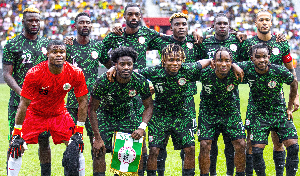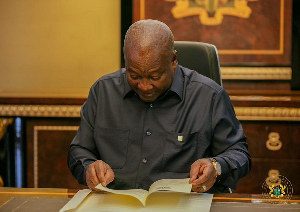I have received a lot of emails asking me to explain why the Denkyira Empire was defeated by the Asantes in 1701 since I am from the royal family of Denkyira State, I’m therefore using the Part 4 of the series to discuss this. I will then continue in Part 5, the reign of King Osei Bonsu of Asante from 1818 to the battle of Akatamanso and give reasons why the Asantes lost to the British and not the Gas and the Akyems as claimed.
In the period leading up to the Feyiase war, large number of Denkyira subjects fled to Kwaman (now Kumasi) to escape the demands of Abankeseso (also known as Ntibanso - a large city with 77 streets watered by seven streams, was the capital of the Denkyira Empire). Abankeseso had a threshold of Abuakwa (in Kumasi) extended northwards to Jacobu in the Amensi Central District. That is it extended six miles radius from which ‘’Osansa’’ (the hawk) could not fly across.
In 1694, King Boa Amponsem I of Denkyira died after 40 years reign; he was succeeded by his relative, Ntim Gyakari (1694-1701). King Ntim Gyakari was philanderer and also a capricious young man of uncertain judgment. His continuous increased in demands provoked resistance from a coalition of his northern tributaries famously led by Osei Tutu of Kumasi. The most important of these demands was when the King sent his messenger, Abebrese, to Kumasi with a message and because Osei Tutu had given protection to Oduro Agyensamoo of Assin (a man wanted in Abankeseso for questioning the King of Denkyira about the circumstances of Boa Amponsem’s death), that because Osei Tutu waged war against Dormaa Kusi of Dormaa his fellow subordinate chief under Denkyira without his permission, the King of Denkyira demanded from the Asantehene the following: firstly, the Asantes should fill the brass-pan (brought by Abebrese) to the brim with pure gold. Secondly, each of the Asante chiefs should send to the King of Denkyira ‘Kyekyerekona’ - a long necklace worn by king’s wives as a sign of submission. Thirdly, each of the Asante chiefs must deliver his favourite wife to the King in marriage. Finally, the Asantehene and each of his provincial chiefs must deliver his beloved child to be sent to Abankeseso.
Another reason was the tyrant rule of King Ntim Gyakari and this led to more than half of Denkyiras fighting alongside with the Asantes against him (Ntim Gyakari).
As Komfo Anokye was famously quoted as saying “all the soldiers of Asante cannot be compared to the smallest wing of the Denkyirahene, so I would change the mind of half of their armies in such a way that during the war, half of them will come to help you.” Whatever the truth is, as a Prince of the Denkyira state, what led to the massive exodus of Denkyiras to Asante was as a result of the punitive ruled of Ntim Gyakari not the so-called miracle claimed to be performed by Anokye Komfo.
The first town which changed allegiance from Ntim Gyakari to Osei Tutu was the Abooso people. Abooso was a town which lay in the vicinity of Adansi Akrokeri and Abankeseso. The inhabitants of this town were called Bontwumafo - the red clay people. The Denkyirahene made ten classes of men and women. These men and women were there to offer their bodies as a sacrificed to the King whenever a member of the royal family pass on and these people were called Bontwumafo [Boa(mponsem’s ntwomafo- red clay people]. That was when any royal personage died, 100 men of these Bontwumafo were sacrificed during the funeral and their blood was used as red clay in painting some parts of the body of the deceased and their bodies were placed in the grave on which the coffin was laid.
Ntim Gyakari, a man famously interested in women, took an Abooso wife. Then his mother fell mortally ill. Learning of this, the wife went to Abooso to alert her ‘‘Bontwumafo’’ kin. When news came that the King’s mother was dead, the Bontwumafo and the inhabitants of the surrounding towns immediately fled to escape being immolated in great numbers and sought refuge with Osei Tutu at Kumasi. After the Feyiase War in 1701, Osei Tutu resettled these Bontwumafo in Atwima (now Atwima Mponua and Atwima Nwabiagya Districts) and their leader was made the Atwimahene.
When it was clear that the Bontwumafo were welcomed by Osei Tutu, others from Denkyira followed in numbers. Aboabo was a town near the Oda River. The town was inhabited by Denkyirahene’s shield-bearers (Akyamfuo) and villagers who prospected for gold on the Ofin flats east of Watreso. A conflict arose between the Akyamfuo and the villagers, and in the course of this, the villagers killed some of the shield-bearers. When Ntim Gyakari was told of the matter, he was incensed and summoned the villagers to appear before him. At the meeting the head of the villagers, Owusu Koanyama abused the Occupant of the Bankam Dwa (the Denkyira Stool) saying that the king’s own servants (the shield-bearers) were ruffians who stole everything from the people. King Ntim Gyakari flew in a rage and ordered that Owusu Koanyama should be killed forthwith together with all his family. This was done on the spot. The villagers and the inhabitants of the towns closed to Aboabo escaped to Asante. However, they took council with themselves to return back to their home and beg the King to forgive them. Ntim Gyakari was in readiness to fight the Feyiase war and so he killed them and these scared the others in exiled to return home. Others of Ntim Gyakari’s household servants who also defected were the brothers Akwadan and Nuamoa, the chief hornblowers of the Denkyirahene. They came to Kumasi with their golden horns and their large followers. They were resettled at Asuoyeboa (in Kumasi), and later brought into Kumasi when Osei Tutu created the Asokwa (in Kumasi) stool for them so that they might act as his traders as well as his hornblowers. Similarly, the Denkyirahene’s head drummer, fled to Osei Tutu with his sister Boatemaa Twum and many followers. Osei Tutu appointed him as Nkukuwafohene. There are many others that cannot be mentioned who came to Asante.
The most important of all those who migrated which drastically reduced Ntim Gyakari’s power and his authority over northern Denkyira were the ‘Inkwayulaes or Nkawie people. Nkawie, 20 miles north of Abankeseso, was the second most important town in the Denkyira Empire. Nkawie was itself a state just like Kwaman (Kumasi) state. It was ruled by a lineage that occupied a Stool from which you become the King of Denkyira. Its female stool was also occupied by Denkyirahene’s ‘nieces’, women who were eligible to become the Queenmother of Denkyira. This was to make the enstoolment of Denkyira Kings smoothly after the King’s death, preventing disputed in the Royal family.
In 1660s, the two royal stools of Nkawie were occupied by Asenso Kufuor and his sister Adoma Akosua [Asenso Kufuor was the Great Grandfather of Nana Kwabena Kufuor who was Nkawiehene (in Ashanti Region) from 1901-1931 and later became Denkyirahene from 1931-1941 with the Stool name Odeefuo Nkwantabisa III. Nana Kwabena Kufuor was also the biological father of former President Kufuor’s mother, Ama Kufuor].
In 1694, after the death of King Boa Amponsem I, Ntim Gyakari won over Asenso Kufuor in the contest to succeed Boa Amponsem. Boa Amponsem however, was not from the Denkyira Royal family but came up to take the Denkyira Stool as he was the famous warrior. So after his death the Denkyiras’ gave the Bankam Dwa also called Offin Ba (a child of the River Offin) in turn to Ntim Gyakari, his relative. Ntim Gyakari feared Kufuor may overthrow him, ordered Asenso Kufuor and his sister Adoma to reside at Abankeseso under surveillance. Asenso Kufuor not satisfied with Ntim Gyakari’s conditions threw in his lot with Osei tutu and came to Kwaman. Since he was a royal eligible to become the King of Denkyira, he came with all his subordinate chiefs together with many guns and gold. Several Denkyira people including royals also followed him.
After Ntim Gyakari was killed at Feyiase, Asenso Kufuor was confirmed in the title of Nkawiehene and went to live in that town but not the old Nkawie which is unknown to geography and archaeology. All of Asenso Kufuor’s lands were restored to him after Bantamahene Apraku, successor of Amankwatia charged Nkawie with having failed in its duty to protect Kumasi from Ebirimoro of Sefwi who attacked Kumasi, whiles the Asantes were still fighting the Akyems. When the case was heard by King Opoku Ware I, Bantamahene declared before the King that Nkawie was a royal of Denkyira Stool and was nursing a hope of breaking off from the Asantehene that is to make himself the King of Denkyira in his turn, hence was not a true Asante Patriot. This made King Opoku Ware infuriated, at this turn of events and he fined Bantamahene as it had spoken to reveal the origins of Nkawie which was forbidden by Asante custom as this prohibition was prominent among the so-called ‘Seventy-seven laws‘ of Komfo Anokye. The King of Asante then allowed them to used the old name ‘Nkawie’ and also extended Nkawie’s lands westward over the Offin River as far as Bibiani in the Western region which they still hold up to now. However, up-to-date the Nkawie stool still remains the seat of Denkyira royalty, as Nana Kwabena Kufuor abdicated the Nkawie stool to occupy the Denkyira Stool after the death of the Denkyirahene, Odeefuo Kwadwo Tibu II in 1931. Also when the Denkyirahene, Odeefuo Owusu Bori II was destooled by Kwame Nkrumah in 1950’s for indulging in politics, came and occupied the Nkawie stool after Nkrumah overthrew when his brother was already occupying the Denkyira Stool.
To conclude, both Denkyira and Asante traditions affirm that Asenso Kufuor shift of allegiance detached the largest state after Abankeseso from Ntim Gyakari’s control, and called into question the reliability of much of northern Denkyira. Therefore, at the end of 1701, when Abankeseso faced the Kwaman coalition that was to become Asante, it had many enemies and few friends and hence caused the fall of the Denkyira Empire.
By: A. M. Kufuor
Email: opemsuo@gmail.com
Facebook: http://m.facebook.com/amkufuor
Opinions of Wednesday, 1 May 2013
Columnist: Kufuor, A. M.
Asante History; Akyem Abuakwa And Dagomba Wars. Part 4
Entertainment













